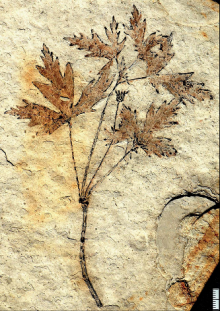Study names new genus of 125-million-year-old eudicot from China

(�鶹��ԺOrg.com) -- A University of Florida researcher has helped describe the earliest known fossil remains of a flowering plant from China that has a direct evolutionary relationship with most plants humans depend on today.
The study, scheduled to appear as the cover story in the March 31 issue of the journal Nature, describes the basal eudicot species, Leefructus mirus, which lived during the early Cretaceous period about 125 million years ago. It is most closely related to living plants in the buttercup family. Eudicots, known as “typical dicots,” are one of the largest groups of flowering plants.
“It is one of the oldest, most complete megafossils in the buttercup family,” said study co-author Hongshan Wang, paleobotany collections manager at the Florida Museum of Natural History on the UF campus. “Flowering plants are what we live on, the food we eat, the crops we have, even the furniture we sit on can come from the hardwood of flowering plants – but for the early history of flowering plants, we know very little, especially when we get into the Cretaceous.”
There are about 250,000 known species of angiosperms, or flowering plants, and this early evidence provides a link to understanding their rapid diversification during the Cretaceous period. Eudicots comprise about 75 percent of all angiosperms today, including peaches, apples, peas, sunflowers and roses.
The fossil was recovered from the middle Yixian Formation in Northeast China, which is part of the Jehol Biota, a community that has been extensively studied because of the unique plant and animal fossils found there.
“A lot of fossils have been found from this biota, which include feathered dinosaurs, early birds, mammals, even a gliding lizard,” Wang said. “All sorts of animals have been found in this area, but I always wonder, ‘What did these animals eat?’ ”
When Leefructus mirus lived, the angiosperms had just started to diversify, Wang said. Based on genetic research, flowering plants are thought to have originated from one common ancestor, and one of Darwin’s “abominable mysteries” was how the many species of flowering plants we know today so quickly diversified from the lower Cretaceous until the middle Cretaceous, about 100 million years ago.
“These discoveries are pushing the age of angiosperms, or at least the age of a rapid diversification in angiosperms back in time,” said William Crepet, chairman of the department of plant biology at Cornell University. “This will have significant implications for dating models of all sorts and may shift our investigations of likely fossils to those found in earlier sediments. This is hence an important discovery.”
The fossil was the first eudicot found in the Yixian Formation and the fifth angiosperm found in the Jehol biota, Wang said. Crepet said the study analysis of the fossil eudicot matches estimates projected from studies using molecular genetics data.
“The authors are contributing importantly to our understanding of angiosperm history through their studies of fossils from these early Cretaceous sediments,” Crepet said. “We are making stepwise but significant progress in addressing our understanding of angiosperm history.”
Study co-authors include Ge Sun of Shenyang Normal University and Jilin University in China; David Dilcher of Shenyang Normal University, Jilin University and Indiana University; and Zhiduan Chen of the Chinese Academy of Sciences.
The fossil analyzed in the study is preserved as an impression in yellowish grey siltstone measuring about 16 centimeters from the stem to the tip of the leaves and the fish Lycoptera davidi was preserved on the same slab. The impression showed a major stem bearing leaves, fruit and a vegetative shoot.
Leefructus mirus was named “Lee,” after the collector, Shiming Li, “fructus,” which means fruiting and “mirus,” which comes from the Latin word mira, or beautiful. Some of the features distinguishing eudicots from other angiosperms are typically net-like vascular tissue in the leaves, pollen grains with three openings and floral organs usually occurring in multiples of four or five. Previous studies of fossilized pollen show the first eudicots appeared about 127 million years ago, 2 million years before Leefructus mirus – the current study describes the first evidence of a fossilized eudicot plant.
“By the mid-Cretaceous, the angiosperms were already dominating almost every terrestrial ecosystem,” Wang said. “It’s important for us to understand the history and early evolution of flowering plants.”
More information: A eudicot from the Early Cretaceous of China, Nature 471, 625–628 (31 March 2011)
Provided by University of Florida



















